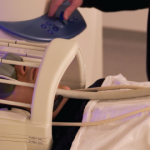A new study suggests that lack of sensory integration may, indeed, underlie the pain associated with fibromyalgia and that the weakening of sensory integration appears to occur at multiple processing levels in patients with fibromyalgia.1
In a paper published online May 2, 2014, in Pain, researchers Jesus Pujol, MD, PhD, director of the MRI Research Unit at Hospital Del Mar in Barcelona, Spain, and colleagues explored the relationship between overall pain sensitivity and changes in functional connectivity within the brain.
The team studied the brains of 40 women with fibromyalgia who reported moderate-to-severe clinical pain ratings and compared them with the brains of 36 control women. Clinical pain was associated with functional connectivity disturbances in: 1) basic levels of pain modulation, 2) cortical sensory areas and 3) parietal operculum/default mode network interaction. Resting-state functional magnetic resonance imaging (fMRI) was used to investigate the neural correlates of clinical pain in fibromyalgia at different levels of somatosensory processing.
The investigators first examined the periaqueductal grey (PAG), an area of the brain traditionally associated with the regulation of pain. The amygdala and insula descend into the PAG, thereby providing it with limbic input. The PAG is also functionally connected to multiple structures in the ventral aspect of the cerebrum (i.e., basal ganglia, thalamus and insula) and in the upper brainstem. The authors found that clinical pain in patients with fibromyalgia correlates with reduced connectivity between PAG and the anterior insula.
The parietal operculum has also been frequently implicated in the response to painful stimulation. The investigators found that individuals with fibromyalgia have decreased regional connectivity within portions of the parietal operculum, including the primary somatosensory cortex and the secondary somatosensory cortex, compared with control subjects.
The authors report that the pain of fibromyalgia is correlated with reduced connectivity between not just the parietal operculum and the primary somatosensory cortex, but also the parietal operculum and visual and auditory cortices. These results suggest a general weakening of sensory cortex connectivity that extends beyond the traditional somatosensory domain.
The investigators also describe alterations between the sensory cortex and other neural systems in patients with fibromyalgia. The alterations appeared to be largely restricted to sensory cortical area; patients with the most pain had the least connectivity. There were no significant increases of intra-regional connectivity in patients with fibromyalgia compared with controls.
Dr. Pujol et al then turned to the default-mode network, which includes brain regions that remain active when the brain is wakeful and the individual is not focused on the outside world. They found that patients with fibromyalgia have increased functional connectivity between the parietal operculum/secondary somatosensory cortex and the default-mode network, including the posterior cingulate cortex, precuneus, ventral putamen and ventral insula. Within the fibromyalgia group, patients with more pain had increased connectivity between the parietal operculum and elements of the default-mode network.
The team noted that patients with fibromyalgia have significantly higher anxiety and depressive symptom ratings than control subjects. Within the fibromyalgia group, researchers did not find a relationship between symptoms of anxiety and depression and pain ratings.
The investigators conclude by proposing that patients with fibromyalgia have an enhanced response to pressure stimuli that allows for spontaneous pain to arise in the absence of painful stimulation. They hypothesize that treatments focused on increasing the tone of nonnociceptive sensory activity, such as peripheral nerve stimulation, vibrotactile stimulation and whole-body vibration therapy, may help patients with fibromyalgia. (posted 7/25/14)
Lara C. Pullen, PhD, is a medical writer based in the Chicago area.
